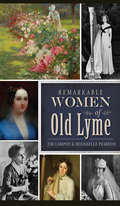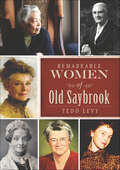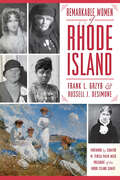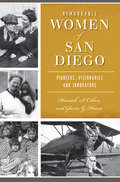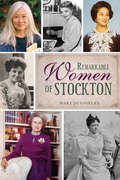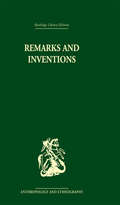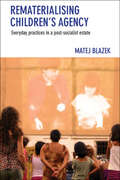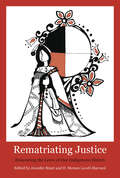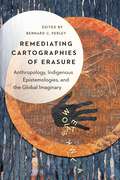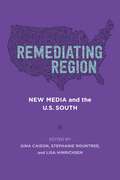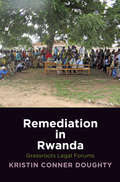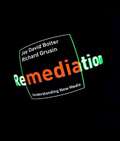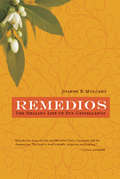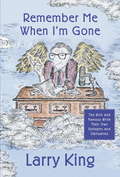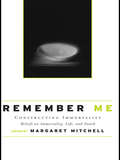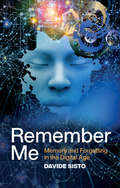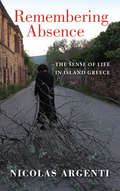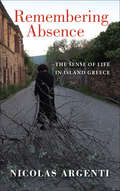- Table View
- List View
Remarkable Women of Old Lyme (American Heritage)
by Jim Lampos Michaelle PearsonOld Lyme's illustrious history owes much to innovative women. Suffragist Katharine Ludington was co-founder of the League of Women Voters. In the 1830s, Phoebe Griffin Noyes started a school for art and general subjects. At the turn of the twentieth century, Florence Griswold welcomed the artists of the Lyme Art Colony by creating the "Birthplace of American Impressionism." By World War II, Teddy Kenyon had made her mark as a test pilot. Old Lyme's artistic tradition was continued by Elisabeth Gordon Chandler, who founded the Lyme Academy College of Fine Arts in 1976. Authors Michaelle Pearson and Jim Lampos honor the women whose triumphs made Old Lyme the popular summer resort and artists' colony it is today.
Remarkable Women of Old Saybrook (American Heritage)
by Tedd LevySituated at the mouth of the Connecticut River, Old Saybrook has been home to generations of remarkable women. The women of this quintessentially New England town have faced and overcome overwhelming adversity to leave indelible marks on their town and its history. Katharine Houghton Hepburn, mother of the legendary actress Katharine Hepburn, organized the Hartford Political Equality League to battle for women's right to vote. Anna Louise James fought to become the first black female pharmacist in Connecticut, and she took care of her community, serving them medicine as well as ice cream sodas at James Pharmacy. There is also local restaurateur Steffie Walters, who after emigrating from Austria remained at the helm of the much-loved shore eatery Dock and Dine for eleven years. Historian Tedd Levy chronicles the achievements of these extraordinary women who broke barriers, changed their communities and expanded opportunities for future generations.
Remarkable Women of Rhode Island (American Heritage)
by Russell J. Desimone Frank L GrzybA chronicle of five centuries of outstanding women who left their mark on the Ocean State.Rhode Island proudly claims a long list of remarkable women throughout history, from pioneering education reformers and suffragettes to trailblazing athletes and authors. In the mid-1800s, Sarah Helen Whitman became a prominent female poet and nearly married Edgar Allan Poe. In 1922, Isabelle Ahearn O&’Neil became the first woman to hold office in the Rhode Island legislature. In the 1940s, Wilma Briggs became the first woman in the state to play on a local high school boys&’ baseball team and went on to join the All-American Girls Professional Baseball League. Join authors Frank L. Grzyb and Russell J. DeSimone in this captivating and insightful account that spans five centuries of women who made history in the smallest state in the nation.
Remarkable Women of San Diego: Pioneers, Visionaries and Innovators (American Heritage)
by Gloria G. Harris Hannah S. CohenSan Diego enjoys a diverse legacy of formidable female leaders. Ellen Browning Scripps financed and established the groundbreaking Scripps Oceanography Institute. In 1927, Belle Benchley became the nation's first female zoo director and for nearly thirty years pioneered new forms of exhibition and developed the world-class San Diego Zoo. Guatemalan activist and advocate Luisa Moreno established the United Fish Cannery Workers Union to protect the rights of workers during World War II. Ruth Alexander set new altitude records for light planes at the peak of the city's aviation boom. Bertha Pendleton became the first female and first African American San Diego school superintendent in 1993. Authors Hannah Cohen and Gloria Harris document these and many more stories of extraordinary local women.
Remarkable Women of Sanibel & Captiva (American Heritage)
by Jeri MaggIn the history of Sanibel and Captiva, countless women bucked the system to make their marks. In the early 1950s and '60s, Sarita Van Vlick and Zee Butler led the fight to preserve the island from unbridled growth and destruction. Helene Gralnick, in the early '80s, opened a small shop that became the foundation for Chico's Inc. And it was city manager Judy Zimomra who put into practice policies that helped Sanibel flourish after the devastation of Hurricane Charley. Author and local historian Jeri Magg compiles the stories and celebrates the achievements of the remarkable women who forever shaped Sanibel and Captiva Islands.
Remarkable Women of Stockton (American Heritage)
by Mary Jo GohlkeWomen played prominent roles during Stockton's growth from gold rush tent city to California leader in transportation, agriculture and manufacturing. Heiresses reigned in the city's nineteenth-century mansions. In the twentieth century, women fought for suffrage and helped start local colleges, run steamship lines, build food empires and break the school district's color barrier. Writers like Sylvia Sun Minnick and Maxine Hong Kingston chronicled the town. Dolores Huerta co-founded the United Farm Workers. Harriet Chalmers Adams caught the travel bug on walks with her father, and Dawn Mabalon rescued the history of the Filipino population. Join Mary Jo Gohlke, news writer turned librarian, as she eloquently captures the stories of twenty-two triumphant and successful women who led a little river city into state prominence.
Remarks and Inventions: Skeptical Essays about Kinship (Routledge Library Editions)
by Rodney NeedhamThis volume scrutinizes the questions of conceptualization, method and history in the fields of kinship, social anthropology and structuralism. It puts forward a radical revision of the conventional approaches and criteria. Exploring analysis and method in the disparity between relative age and kinship categories as means of social classification, the book makes theoretical readjustments, largely inspired by the precepts of Wittgenstein. Originally published in 1971.
Rematerialising Children's Agency: Everyday Practices in a Post-Socialist Estate
by Matej BlazekThis book is a detailed study of children’s everyday practices in a small, deprived neighbourhood of post-socialist Bratislava, called Kopčany. It provides a novel empirical insight on what it is like to be growing up after 25 years of post-socialist transformations and questions the formation of children’s agency and the multitude of resources it comes from. What happens if we accept children’s practices as cornerstones of communities? What is uncovered if we examine adults' co-presence with children in everyday community spaces? With a background in youth work, the author writes from the unique position of being able to develop in-depth insights into both children’s life-worlds, and practitioners’ priorities and needs.
Rematriating Justice: Honouring the Lives of Our Sisters in Spirit
by Jennifer Brant;D. Memee Lavell-HarvardIn June 2019, the National Inquiry into Missing and Murdered Indigenous Women and Girls released its Final Report titled Reclaiming Power and Place. The report documented 231 “ Calls for Justice” demanding immediate action against racialized, sexualized and gender-based violence. The report condemned Canadian society for its inaction and described the violence as “ a national tragedy of epic proportion.” It has been eight years since the release of Forever Loved: Exposing the Hidden Crisis of Missing and Murdered Indigenous Women and Girls in Canada (2016) and four years since the release of Reclaiming Power and Place and we continue to witness racialized, sexualized and gender-based violences across Turtle Island. This book contributes to these Calls for Justice by demanding accountability and policy change. The book centres the voices of Indigenous women, families and communities by offering essays, testimonies, and reflections that honour collective calls to rematriate justice for our Indigenous sisters.
Remedial Education (Routledge Library Editions: Special Educational Needs #44)
by Olive C. SampsonFirst published in 1975. Remedial education aims to help the pupil who is failing. It is richly rewarding to the committed teacher but makes great demands on him. Olive Sampson, whose conviction of the importance of this form of schooling is based on extensive personal experience and research, gives an objective account of its history, present status and best practices.
Remediating Cartographies of Erasure: Anthropology, Indigenous Epistemologies, and the Global Imaginary
by Bernard C. PerleyRemediating Cartographies of Erasure brings together leading sociocultural and linguistic anthropologists to explore the moral imperatives of anthropology as a discipline to contribute to the self-determination and equality of Indigenous peoples around the globe. This engaged collaboration highlights the partnerships between Indigenous communities and anthropology as a mutually respectful and emancipatory practice of Indigenous and anthropological epistemologies. Indigenous scholars from New Zealand, the United States, and Canada and non-Indigenous scholars from Australia, the United States, and Canada each provide concrete examples of how researchers actualize the moral imperative to work with Indigenous peoples in ways that foster their human rights and self-determination. The contributors discuss anthropological work done in Canada, the United States, Brazil, Peru, Bolivia, Honduras, Australia, Sardinia, and New Zealand. In laying out a world anthropology, this volume demonstrates the rectification practices of Indigenous peoples and continues anthropology&’s long-standing advocacy for social justice and human rights around the globe.
Remediating Region: New Media and the U.S. South (Southern Literary Studies)
by Leigh H. Edwards Scott Romine David A. Davis Jennie Lightweis-Goff Sherita L. Johnson Alexandra Chiasson Paul Fess Sam McCracken Margaret T. McGehee Jean-Luc Pierite Jae Sharpe Austin SvedjanRather than a media history of the region or a history of southern media, Remediating Region: New Media and the U.S. South formulates a critical methodology for studying the continuous reinventions of regional space across media platforms. This innovative collection demonstrates that structures of media undergird American regionalism through the representation of a given geography’s peoples, places, and ideologies. It also outlines how the region answers back to the national media by circulating ever-shifting ideas of place via new platforms that allow for self-representation outside previously sanctioned media forms.Remediating Region recognizes that all media was once new media. In examining how changes in information and media modify concepts of region, it both articulates the virtual realities of the twenty-first-century U.S. South and historicizes the impact of “new” media on a region that has long been mediated. Eleven essays examine media moments ranging from the nineteenth century to the present day, among them Frederick Douglass’s utilization of early photography, video game representations of a late capitalist landscape, rural queer communities’ engagement with social media platforms, and contemporary technologies focused on revitalizing Indigenous cultural practices.Interdisciplinary in scope and execution, Remediating Region argues that on an increasingly networked planet, concerns over the mediated region continue to inform how audiences and participants understand their entrée into a global world through local space.
Remediation in Rwanda: Grassroots Legal Forums (The Ethnography of Political Violence)
by Kristin Conner DoughtyKristin Conner Doughty examines how Rwandans navigated the combination of harmony and punishment in grassroots courts purportedly designed to rebuild the social fabric in the wake of the 1994 genocide. Postgenocide Rwandan officials developed new local courts ostensibly modeled on traditional practices of dispute resolution as part of a broader national policy of unity and reconciliation. The three legal forums at the heart of Remediation in Rwanda—genocide courts called inkiko gacaca, mediation committees called comite y'abunzi, and a legal aid clinic—all emphasized mediation based on principles of compromise and unity, brokered by third parties with the authority to administer punishment. Doughty demonstrates how exhortations to unity in legal forums served as a form of cultural control, even as people rebuilt moral community and conceived alternative futures through debates there. Investigating a broad range of disputes, she connects the grave disputes about genocide to the ordinary frictions people endured living in its aftermath.Remediation in Rwanda is therefore about not only national reconstruction but also a broader narrative of how the embrace of law, particularly in postconflict contexts, influences people's lives. Though law-based mediation is framed as benign—and is often justified as a purer form of culturally rooted dispute resolution, both by national governments such as Rwanda's, and in the transitional justice movement more broadly—its implementation, as Doughty reveals, involves coercion and accompanying resistance. Yet in grassroots legal forums that are deeply contextualized, law-based mediation can open up spaces in which people negotiate the micropolitics of reconciliation.
Remediation: Understanding New Media
by Jay David Bolter Richard GrusinMedia critics remain captivated by the modernist myth of the new: they assume that digital technologies such as the World Wide Web, virtual reality, and computer graphics must divorce themselves from earlier media for a new set of aesthetic and cultural principles. In this richly illustrated study, Jay David Bolter and Richard Grusin offer a theory of mediation for our digital age that challenges this assumption. They argue that new visual media achieve their cultural significance precisely by paying homage to, rivaling, and refashioning such earlier media as perspective painting, photography, film, and television. They call this process of refashioning "remediation", and they note that earlier media have also refashioned one another: photography remediated painting, film remediated stage production and photography, and television remediated film, vaudeville, and radio. <P>In chapters devoted to individual media or genres (such as computer games, digital photography, virtual reality, film, and television), Bolter and Grusin illustrate the process of remediation and its two principal styles or strategies: transparent immediacy and hypermediacy. Each of these strategies has a long and complicated history. A painting by the seventeenth-century artist Pieter Saenredam, a photograph by Edward Weston, and a computer system for virtual reality are all attempts to achieve transparent immediacy by ignoring or denying the presence of the medium.
Remedios
by Joanne B. MulcahyFormer President Ronald Reagan called Eva Castellanoz a "national treasure" when he awarded her an NEA National Heritage Fellowship in 1987. Featured in National Geographic, National Public Radio, and numerous other publications, Castellanoz is celebrated as a folk artist, community activist and a curandera, a traditional Mexican healer who uses a mind-body-spirit approach. During her 16 year friendship with Joanne Mulcahy, Castellanoz has revealed her life story as well as her remedios - her remedies, both medicinal and metaphoric - for life's maladies. Using her own observations and Castellanoz's stories, Mulcahy employs creative nonfiction and oral accounts to portray the life, beliefs, and practices of this remarkable woman. Anyone who has been healed by Eva Castellanoz has felt her power and wisdom. Anyone who reads this vivid portrait will come away feeling wiser and empowered by the story of this courageous and loving healer.
Remedios
by Joanne B. MulcahyFormer President Ronald Reagan called Eva Castellanoz a "national treasure" when he awarded her an NEA National Heritage Fellowship in 1987. Featured in National Geographic, National Public Radio, and numerous other publications, Castellanoz is celebrated as a folk artist, community activist and a curandera, a traditional Mexican healer who uses a mind-body-spirit approach. During her 16 year friendship with Joanne Mulcahy, Castellanoz has revealed her life story as well as her remedios - her remedies, both medicinal and metaphoric - for life's maladies. Using her own observations and Castellanoz's stories, Mulcahy employs creative nonfiction and oral accounts to portray the life, beliefs, and practices of this remarkable woman. Anyone who has been healed by Eva Castellanoz has felt her power and wisdom. Anyone who reads this vivid portrait will come away feeling wiser and empowered by the story of this courageous and loving healer.
Remember Me When I'm Gone: The Rich and Famous Write Their Own Epitaphs and Obituaries
by Larry King“Show me Heaven! I have seen hell.” —Patricia NealLarry King, world-famous radio and television personality, has asked the talented, the beautiful, the wise, and the rich a question all of us have pondered: How would you like to be remembered after your death? The result is REMEMBER ME WHEN I'M GONE, an entertaining and eloquent collection of “last words” from people in the arts, in politics, in sports, and in business, mostly still alive. In telling and moving reflections, often leavened by self-deprecating humor, these celebrities look back on their lives, their ambitions, their mistakes, and their accomplishments.The contributions range from pithy one-liners by Yogi Berra (“It’s over.”), Dave Barry, George Carlin, and Liz Smith (“Excuse my dust!”); to inspired sketches by Stephen King and Peter Falk; to candid reflections from Don Shula, Fred Rogers, and Chevy Chase; to hilarious rants from Margaret Cho and Tommy Lee; and a last request by Arthur Hailey. Often surprising and always memorable, REMEMBER ME WHEN I'M GONE is a timeless collection by stars who will live on forever.
Remember Me: A Lively Tour of the American Way of Dea
by Lisa Takeuchi CullenIn Remember Me, Time writer Lisa Takeuchi Cullen has created a humorous and poignant chronicle of her travels around the country to discover how Americans are reinventing the rites of dying. What she learned is that people no longer want to take death lying down; instead, they're taking their demise into their own hands and planning the afterparty. Cullen hears stories of modern-day funerals: lobster-shaped caskets and other unconventional containers for corpses; cremated remains turned into diamonds; and even mishaps like dove releases gone horribly wrong. Eye-opening, funny, and unforgettable, Remember Me gives an account of the ways in which Americans are designing new occasions to mark death—by celebrating life.
Remember Me: Constructing Immortality - Beliefs on Immortality, Life, and Death
by Margaret MitchellRemember Me brings together contributors from around the world with unique insight on the ways in which one's relationship with loved ones continues, endures, and perhaps even grows after death. Much of the available literature speaks of healthy bereavement as letting go of the deceased and moving forward with life. This new text challenges that notion, discussing the meaning attributed to death and to the anticipation of death. The living, as presented in these innovative chapters, construct social entities of those who have died, via the carrying out of wishes in the Will; pursuing legal claims; or simply attributing certain desires, emotions, or choices to the deceased reconstitutes them as active, even vital, voices even after biological death. Just as life itself, the end of life and death is an interdisciplinary matter. A clear psychological theme and focus ties together these perspectives under three conceptual areas: the anticipation of death; the social life of the deceased and the legal embodiment of the deceased.
Remember Me: Memory and Forgetting in the Digital Age
by Davide SistoAs the end of December draws near, Facebook routinely sends users a short video entitled ‘Your Year on Facebook’. It lasts about a minute and brings together the images and posts that received the highest number of comments and likes over the last year. The video is rounded off with a message from Facebook that reads: ‘Sometimes, looking back helps us remember what matters most. Thanks for being here.’ It is this ‘looking back’, increasingly the focus of social networks, that is the inspiration behind Davide Sisto’s brilliant reflection on how our relationship with remembering and forgetting is changing in the digital era. The past does not really exist: it is only a story we tell ourselves. But what happens when we tell this story not only to ourselves but also to our followers, when it is recorded not only on our social media pages but also on the pages of hundreds or thousands of others, making it something that can be viewed and referenced forever? Social media networks are becoming vast digital archives in which the past merges seamlessly with the present, slowly erasing our capacity to forget. And yet at the same time, our memory is being outsourced to systems that we don’t control and that could become obsolete at any time, cutting us off from our memories and risking total oblivion. This timely and thoughtful reflection on memory and forgetting in the digital age will be of interest to students and scholars in media studies and to anyone concerned with the ways our social and personal lives are changing in a world increasingly shaped by social media and the internet.
Remember the 70s
by Derek TaitFrom Bohemian Rhapsody and David Bowie to Star Wars and Watergate, the history of an unforgettable era that rocked (and discoed) the world. The 1970s was one of the most exciting, innovative, and colorful decades of the twentieth century. It was ten years of major events in music (Freddie Mercury, The Sex Pistols, The Carpenters, and Blondie), film (Jaws, Dirty Harry, The Godfather, and Saturday Night Fever), television (The Mary Tyler Moore Show, All in the Family, Benny Hill, and The Waltons), and politics (Richard Nixon, Margaret Thatcher, and Jane Fonda). It was also a time of social change (the women’s movement and gay rights), and unforgettable nutty trends (orange shag carpets, bell bottoms, platform shoes, and wing-collared shirts). From home-life and fashions to entertainment, sports, headlining-making crimes, and pioneering new technologies, Remember the 70s is a fabulous record of a chaotic, pivotal, loud, and revolutionary era. For those who lived through it, and for those who just heard about it, historian Derek Tait (who came of age in it—and has the photos to prove it) offers fascinating insights, truths, and reflections into a dazzling pop-culture turning point that resonates to this day.
Remember the Ladies: Celebrating Those Who Fought for Freedom at the Ballot Box
by Angela P. DodsonFollowing the centennial celebrations of women first winning the right to vote, this book documents the milestones in the hard-won struggle and reflects on women's impact on politics since. From the birth of our nation to the recent crushing defeat of the first female presidential candidate, this book highlights women's impact on United States politics and government. It documents the fight for women's right to vote, drawing on historic research, biographies of leaders, and such original sources as photos, line art, charts, graphs, documents, posters, ads, and buttons. It presents this often-forgotten struggle in an accessible, conversational, relevant manner for a wide audience. Here are the groundbreaking convention records, speeches, newspaper accounts, letters, photos, and drawings of those who fought for women's right to vote, all in their own words, arranged to convey the inherent historical drama. The accessible almanac style allows this entertaining history speak for itself. It is full of little-known facts. For instance: When the Constitutional Convention of the thirteen colonies convened to draft the Constitution, Abigail Adams admonished her husband John Adams to "remember the ladies" (write rights for women into the Constitution!). Important for today's discussions, Remember the Ladies does not extract women's suffrage from the inseparable concurrent historic endeavors for emancipation, immigration, and temperance. Its robust research documents the intersectionality of women's struggle for the vote in its true context with other progressive efforts.
Remembering Absence: The Sense of Life in Island Greece (New Anthropologies of Europe)
by Nicolas ArgentiDrawing on research conducted on Chios during the sovereign debt crisis that struck Greece in 2010, Nicolas Argenti follows the lives of individuals who symbolize the transformations affecting this Aegean island. As witnesses to the crisis speak of their lives, however, their current anxieties and frustrations are expressed in terms of past crises that have shaped the dramatic history of Chios, including the German occupation in World War II and the ensuing famine, the exchange of populations between Greece and Turkey of 1922–23, and the Massacres of 1822 that decimated the island at the outset of the Greek War of Independence. The complex temporality that emerges in these accounts is ensconced in a cultural context of commemorative ritual, ecstatic visions, an annual rocket war, and other embodied practices that contribute to forms of memory production that question the assumptions of the trauma discourse, revealing the islanders of Chios to be active in forging their place in time in a manner that blurs the boundaries between historiography, memory, religion, and myth. A member of the Chiot diaspora, Argenti makes use of unpublished correspondence from survivors of the Massacres of 1822 and their descendants and reflects on oral family histories and silences in which the island represents an enigmatic but palpable absence. As he explores the ways in which a body of memory and a cultural experience of temporality came to be dislocated and shared between two populations, his return to Chios marks an encounter in which the traditional roles of ethnographer and participant come to be dispersed and intertwined.
Remembering Absence: The Sense of Life in Island Greece (New Anthropologies of Europe)
by Nicolas ArgentiA journey through an Aegean island community’s history of massacre, occupation, famine, and financial meltdown—and its effects on culture and memory.Drawing on research conducted on Chios during the sovereign debt crisis that struck Greece in 2010, Nicolas Argenti follows the lives of individuals who symbolize the transformations affecting this Aegean island. As witnesses to the crisis speak of their lives, however, their current anxieties and frustrations are expressed in terms of past crises that have shaped the dramatic history of Chios, including the German occupation in World War II and the ensuing famine, the exchange of populations between Greece and Turkey of 1922–23, and the Massacres of 1822 that decimated the island at the outset of the Greek War of Independence. The complex temporality that emerges in these accounts is ensconced in a cultural context of commemorative ritual, ecstatic visions, an annual rocket war, and other embodied practices that contribute to forms of memory production that question the assumptions of the trauma discourse, revealing the islanders of Chios to be active in forging their place in time in a manner that blurs the boundaries between historiography, memory, religion, and myth.A member of the Chiot diaspora, Argenti makes use of unpublished correspondence from survivors of the Massacres of 1822 and their descendants and reflects on oral family histories and silences in which the island represents an enigmatic but palpable absence. As he explores the ways in which a body of memory and a cultural experience of temporality came to be dislocated and shared between two populations, his return to Chios marks an encounter in which the traditional roles of ethnographer and participant come to be dispersed and intertwined.
Remembering African Labor Migration to the Second World: Socialist Mobilities between Angola, Mozambique, and East Germany (Palgrave Macmillan Transnational History Series)
by Marcia C. SchenckThis open access book is about Mozambicans and Angolans who migrated in state-sponsored schemes to East Germany in the late 1970s and throughout the 1980s. They went to work and to be trained as a vanguard labor force for the intended African industrial revolutions. While they were there, they contributed their labor power to the East German economy. This book draws on more than 260 life history interviews and uncovers complex and contradictory experiences and transnational encounters. What emerges is a series of dualities that exist side by side in the memories of the former migrants: the state and the individual, work and consumption, integration and exclusion, loss and gain, and the past in the past and the past in the present and future. By uncovering these dualities, the book explores the lives of African migrants moving between the Third and Second worlds. Devoted to the memories of worker-trainees, this transnational study comes at a time when historians are uncovering the many varied, complicated, and important connections within the global socialist world.
